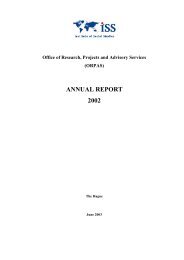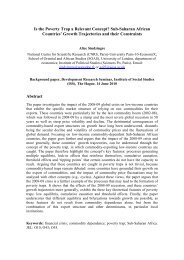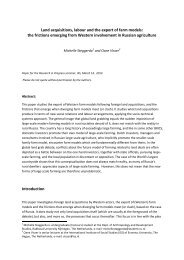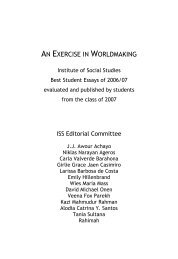AN EXERCISE IN WORLDMAKING 2009 - ISS
AN EXERCISE IN WORLDMAKING 2009 - ISS
AN EXERCISE IN WORLDMAKING 2009 - ISS
You also want an ePaper? Increase the reach of your titles
YUMPU automatically turns print PDFs into web optimized ePapers that Google loves.
118 ISABELLE TURCOTTE<br />
improving revenue for investments in local service provision and industry<br />
development. Administrative decentralization aimed at strengthening decision<br />
making autonomy for improved project execution and overall<br />
management of resources. Lastly, political decentralization aspired to augment<br />
the accountability of state agents through the election of mayors<br />
and governors. As stated by Fiszbein, local governments improved the<br />
execution of their functions through selectivity and specialization, meaning<br />
that municipalities focused on relatively fewer priorities, and avoided doing<br />
everything by itself, rather implementing projects with the involvement<br />
of external community actors (Fiszbein, 1997: 1039).<br />
Political involvement, however, has historically stood as a principal<br />
challenge to plural participation in the construction of domestic policy.<br />
The composition of the new Constitution of 1991 came at an important<br />
crossroad in Colombian history and had lasting political bearings. At this<br />
time, struggle for power and dominance encouraged pervasive clashes<br />
between different factions’ armed groups. The turbulences created confusion<br />
and popular mobilization instigating projects of political reform.<br />
This concretized through the platform of the National Assembly which,<br />
for the first time in Colombian history, represented the principal societal<br />
constituencies, implying the involvement of groups that had been formally<br />
excluded from political debate. The negotiations put forth an ambitious<br />
document recognized as “[one of the most] progressive project[s]<br />
in contemporary constitutional thought” as it combined two principal<br />
axes: that of a social constitution formalizing an extensive bill of rights, and<br />
on the other fortifying the institutions required for continued efficient<br />
management of economic affairs, both rivaling as paradigms in the new macropolitical<br />
reality (Murillo and Gomez, 2005: 3).<br />
The Constitutional court appeared as being one of the most important<br />
new institutions in administering justice and ensuring compliance<br />
with the Constitution. It has not only been used to reinforce the legislative<br />
branch relative to very strong presidential power, a legacy of the<br />
1886 Constitution, but also mediated the clash between the social rights<br />
and neoliberal attitudes adopted by the elites in power. An interesting<br />
debate on pensions arose. The Constitution officially grants this right of<br />
subsistence to its citizens, yet economic arguments related to the insufficiency<br />
of state funds to guarantee citizens this benefit has often been<br />
used in justifying the non-compliance to this basic constitutional right<br />
(Murillo and Gomez, 2005: 8). The position of the Constitutional court
















